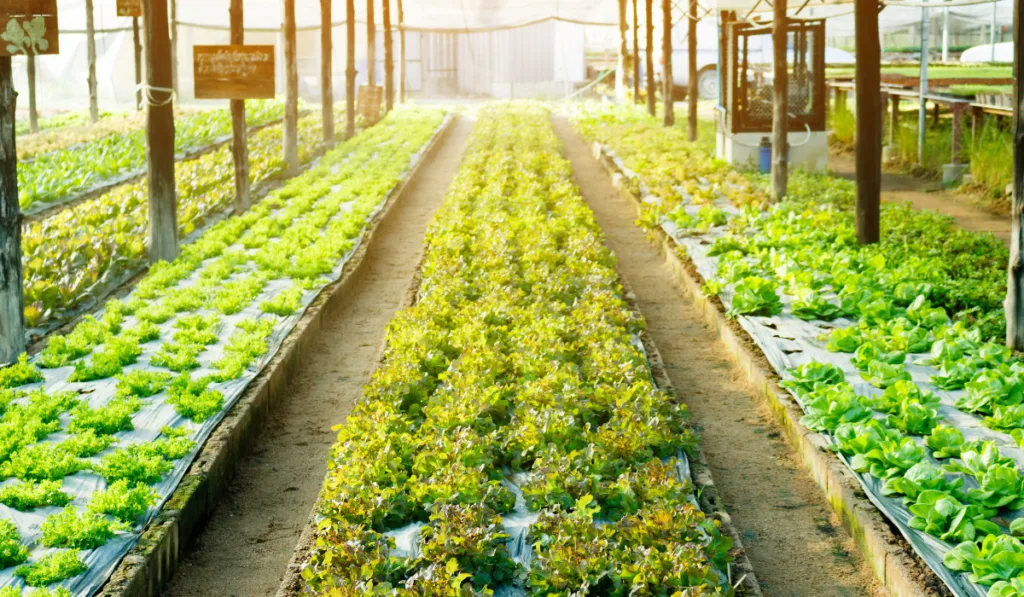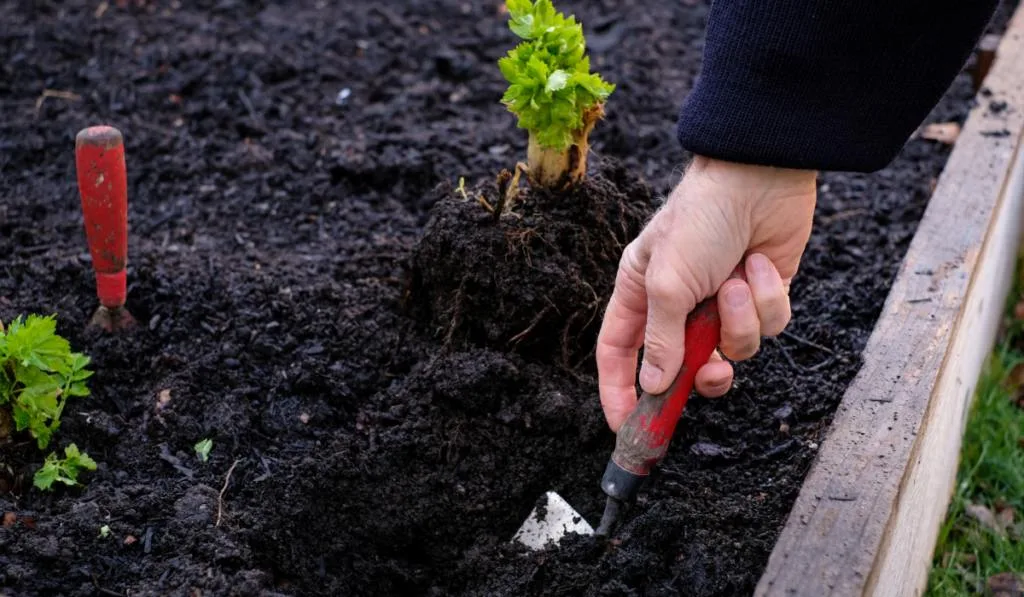Farmers have practiced crop rotation for hundreds of years. Rotating legume crops with grains and forage grasses is part of the foundation of many farms and ranches. On this larger scale, studies show that crop rotation increases yield in corn and soybeans by up to 15%.

Crop rotation involves growing different crops in a particular sequence over a period of time.
However, the crops must complement each other to boost the soil nutrients instead of depleting them.
Also, you can use crop rotation to incorporate “fallow periods”—which are when you leave a portion of your garden fallow (not planted) as part of crop rotation to allow the soil to rest and regenerate.
But, this success rate does not involve guesswork, because crop rotation is a tried and tested recipe that guarantees success every time. It is a choreographed routine of moving your crops from one spot to another, keeping your garden happy and healthy.
Here is how you can use crop rotation to reap bountiful rewards.
Table of Contents
Plan for Crop Rotation
Planning allows you to strategically rotate crops in a manner that the one before compliments the next one.
For example, the table below shows some crops you can rotate as they complement each other.
| Rotation 1 | Rotation 2 | Reason for Rotation |
| Leafy Greens | Tomatoes | Leafy greens help suppress soil-borne diseases that plague tomatoes. |
| Legumes | Corn | Legumes fix nitrogen in the soil, benefiting nitrogen-demanding crops like corn. |
| Cabbage | Root vegetables like radishes and carrots | Root vegetables break up compacted soil left by cabbage and improve soil structure. |
| Squash | Peppers | Squash are heavy feeders, unlike peppers that thrive in soil with moderate levels of fertility. |
| Potatoes | Beans | Potatoes break up soil, using their fibrous root system, while beans enrich the soil with nitrogen. |
But first, there are factors you need to consider before you can create a crop rotation plan.
These include:
1. Assess the Size of Your Vegetable Garden
This helps to determine the condition of the soil.
Here is why:
Soil health involves understanding the soil types in your garden, fertility, pH level, and nutrient content.
Knowing which crops complement each other nutrition-wise allows to you form a rotation plan.
2. Divide the Space Into Planting Areas
For example, using the table above, you can divide your garden into three planting areas.
- Plant leafy greens, legumes such as beans or peas, and cabbage in each section for rotation 1.
- Then plant tomatoes, corn, and root vegetables during rotation 2.
Tip: Start a garden journal to help you document plant performance, growth patterns, and harvest yields. A journal will help you know which plants thrive in each rotation and which ones do not so that you can try new plants in the next cycle.
3. Understand the Benefits of Crop Rotation

The act of rotating crops that complement each other nutrition-wise has numerous benefits for both the soil and the crops.
These include:
A. Enhanced Soil Fertility
Different crops have varying nutrients that they absorb from or add to the soil.
For instance, legumes enrich the soil with nitrogen, while corn feeds on nitrogen from the soil to grow and produce high yields.
Crop rotation helps optimize nutrient availability and utilization more sustainably.
B. Enhanced Crop Yields
Crop rotation improves the nutrients in the soil.
It enhances high crop yields, which leads to economic benefits if you are farming commercially.
Crop rotation reduces the need to use inorganic fertilizers while minimizing the risk of plant loss, as it reduces pests and diseases.
C. Weed Control
Different weed varieties thrive in between different crops.
For example, wild mustard grows alongside cabbage, while other weeds grow with carrots.
Therefore by alternating between cabbage and carrots, you control the growth of plant-specific weeds.
D. Nutrient Management, Increased Biodiversity, and Ecosystem Resilience
Crop rotation promotes plant growth by allowing better nutrient management. This also reduces crop failure, as you improve the soil nutrients without using chemical fertilizers.
Crop rotation invites pollinators, natural predators, and beneficial soil microbes, creating a sustainable ecosystem.
4. Use the Four-Field or Three-Year Rotation Plan
A three-year rotation plan involves using years as the basis for your rotation.
That is, you divide your garden into three sections and plant vegetables that add nutrients to the soil, then rotate them yearly.

For example, you can plant peas, broccoli, and garlic.
Peas enrich the soil with nutrients, which broccoli absorbs, while garlic helps manage weeds and disease.
Then you can rotate the variables in year 2. Plant peas where the garlic was; broccoli where the peas were, and garlic where the broccoli was.
In year 3, shift each crop into the next section.
On the other hand, a four-field rotation plan works just like a three-year one.
But in this case, you divide your garden into four sections and you determine how long you can keep a vegetable growing.
You can do a yearly or two-year rotation.
Tips to Consider
Whichever rotation method you choose, consider
- Planting vegetables that have complementary nutrient needs.
- Mixing susceptible and non-susceptible crops.
Susceptible vegetables are vulnerable to pests, diseases, weeds, and other environmental factors. If you plant susceptible plants like tomatoes or potatoes without rotating them with non-susceptible plants such as beans, kale, or onions, that increases the occurrence of pests and diseases. It also leads to a lower crop yield. - Planting green manure cover crops like legumes and brassica.
Green manure cover crops help fix and improve soil health and fertility by fixing nitrogen, suppressing weeds, and enhancing the soil structure.

Implementing Crop Rotation
After making a crop rotation plan, it’s time to implement it.
Here is how you do it:
- Prepare the soil to ensure that it meets the optimal conditions for the upcoming crops.
- Consider nutrient requirements.
Some plants are heavy feeders, while others amend the soil fertility by adding nutrients as shown in the table above. Still, you can add organic matter at this point to add more nutrients to the soil.
Tip: You can make organic fertilizer from fruit and vegetable scraps, eggshells, coffee grounds, and banana peels. Spraying your plants with banana peel-steeped water for over a week enriches them with potassium, magnesium, and calcium, which boosts growth, especially with tomatoes.
- Diversify the crop types. As you plan your crop rotation, include different crop types like grains, legumes, vegetables, and cover crops. This helps break pest and disease cycles promoting a balanced diet for your plants.
- Incorporate nutrient-fixing plants like beans, peas, lentils, clover, or any other legumes.
- Monitor your plants’ performance. In your garden journal, note the dates of planting, growth pattern, any pests or disease occurrence, and yield.
Also, assess the soil health and fertility, then add organic matter as needed. Observe any pests or diseases that may occur.
Tip: Watch how the foliage forms by taking note of the various leaf colors and textures. Healthy green leaves should have a rich, uniform color. Pale, yellow, or discolored leaves may indicate underlying issues like nutrient deficiencies or pest infestation.
- Use Integrated Pest Management (IPM) and/or plant disease-resistant crop varieties (explained below).

Common Crop Rotation Challenges
Like most gardening practices, crop rotation has its share of challenges.
These include:
A. Pests and Diseases
Although one of the benefits of crop rotation is to manage pests, some populations may have longer survival periods.
So how do you prevent these diseases and pests?
You can use Integrated Pest Management (IPM). IPM involves regularly scouting your garden to identify pests and monitor their activity.
Searching for pests helps you understand what to do regarding pest control in your garden and ensures you make timely interventions.
Timely intervention for reducing pests in your garden is crucial.
You can use more environmentally friendly pest control measures like natural predators and beneficial organisms that prey on pests.
Choose predatory nematodes, which are effective predators of soil-dwelling pests like root-knot nematodes and cutworms.
But if using predatory nematodes isn’t enough to control pests, you can use pesticides.
Follow the label instructions when applying pesticides to ensure you do not harm beneficial organisms and the environment.
Additionally, you can prevent or limit prevalent diseases in your region by consulting agricultural experts so that they can recommend disease-resistant crop varieties.
B. Nutrient Imbalances and Depletion

If you choose crops for rotation that do not complement each other, they may end up damaging the soil.
Why?
If the only thing plants are doing is feeding on nutrients in the soil, they will deplete the levels of nutrients or create imbalances.
The result is a decreased yield and reduced overall soil fertility, which can negatively impact the long-term sustainability and productivity of your gardening endeavors.
C. Climate and Weather Constraints
Climate change and unpredictable weather impact crop rotation and overall crop yield. This is because it causes early or late frosts or heavy, prolonged rainfall, and affects the growing seasons.
However, you can use the following preventive measures:
- Irrigate during drought or reduced rainfall. Optimize water usage while minimizing wastage by using irrigation practices like drip or precision sprinklers.
- Plant cover crops during fallow periods. Cover crops help manage excessive rainfall by preventing soil erosion. Cover cropping acts as a protective layer that reduces water runoff, thus retaining soil moisture and nutrient cycling.
- Till the soil conservatively. Conservation tillage involves minimal to no soil disturbance during crop production, which preserves soil structure, minimizes erosion, and retains moisture.
Conclusion
Understanding crop rotation is fundamental if you want to achieve a successful vegetable garden. You can enjoy bountiful rewards when you feed nutrients to the soil, which in turn feeds the growing plants.
This leads to enhanced soil fertility, increased biodiversity, and improved ecosystem resilience — all of which lead to successful gardening.
But, crop rotation is not as easy as it sounds. You need to understand your soil type and the vegetables that grow well in your zone.
However, using this guide will help you create a harmonious and thriving vegetable garden. Continue to document your journey, learn from your failures, embrace your successes, and above all seek advice from agricultural experts to optimize your crop rotation practices.
Resources:
- https://horticulture.co.uk/crop-rotation/
- https://www.almanac.com/crop-rotation-101-tips-vegetable-gardens
- https://eos.com/blog/crop-rotation/
- https://www.sciencedirect.com/topics/earth-and-planetary-sciences/crop-rotation
- https://vlsci.com/blog/crop-rotation-benefits/ **
- https://www.nohttps://www.amazon.com/dp/1641780770?tag=crateandbasket-20ble.org/news/publications/ag-news-and-views/2013/november/crop-rotation-yields-many-benefits/
- https://wilkes.ces.ncsu.edu/2014/12/advantages-of-crop-rotation/
- https://usfarmersandranchers.org/stories/sustainable-food-production/the-benefits-of-crop-rotation-and-diversity/
- https://www.ncbi.nlm.nih.gov/pmc/articles/PMC8878687/
- https://www.gardenmyths.com/legumes-add-nitrogen-soil/
- https://www.growveg.co.uk/guides/growing-vegetables-in-clay-soil/
- https://flourishingplants.com/banana-peel-water-for-plants/
- https://www.amazon.com/dp/1641780770?tag=crateandbasket-20
